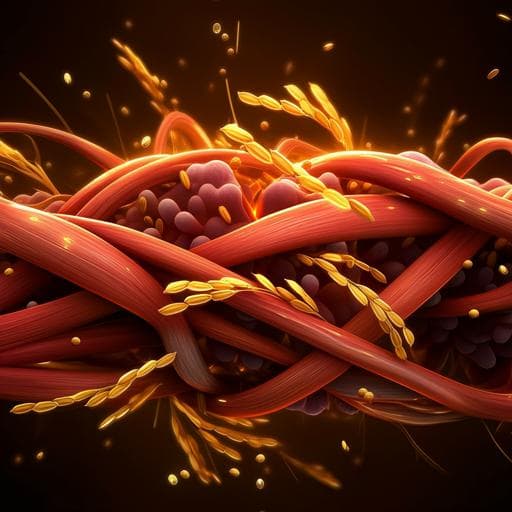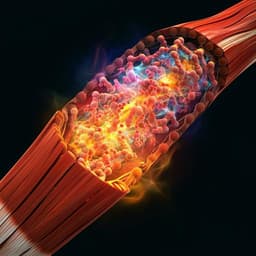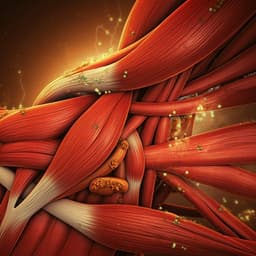
Medicine and Health
Oral intake of rice overexpressing ubiquitin ligase inhibitory pentapeptide prevents atrophy in denervated skeletal muscle
R. Nakao, W. Shen, et al.
This research conducted by Reiko Nakao and colleagues explores the oral absorption of a novel CBLB inhibitory pentapeptide (Cblin) for preventing muscle atrophy. Results indicate that mice fed genetically modified rice (CbR) containing Cblin experienced lesser muscle mass loss and exhibited lower levels of atrophy-related proteins, positioning CbR as a potential innovative treatment in muscle preservation.
~3 min • Beginner • English
Introduction
Skeletal muscle growth is largely governed by IGF-1 signaling. Under unloading/disuse conditions (e.g., space flight, tail suspension, sciatic denervation), expression of the ubiquitin ligase CBLB increases, which promotes ubiquitination and degradation of IRS1, attenuating IGF-1 signaling and driving upregulation of atrophy-related ubiquitin ligases (MAFbx/atrogin-1, MuRF1) via FOXO3 activation. Prior work showed Cblb-deficient mice resist unloading-induced atrophy and that a designed inhibitory pentapeptide (Cblin; Asp-Gly-pTyr-Met-Pro), which mimics pTyr608 of IRS1 and binds the CBLB TKB domain, prevents IRS1 ubiquitination and muscle loss when injected intramuscularly. However, injections are invasive. While di- and tripeptides are well-known to be absorbed via PEPT1, absorption of longer oligopeptides (≥4 residues), including Cblin, is less clear though some can cross epithelia via paracellular routes. The authors also hypothesized that dietary proteins releasing Cblin-like sequences could protect muscle. This study asks whether Cblin pentapeptides can be absorbed intact from the intestine and whether a transgenic rice enriched in a Cblin-like peptide (CbR) can prevent denervation-induced skeletal muscle atrophy in rodents.
Literature Review
Background literature establishes: (1) the central role of IGF-1/IRS1 signaling in muscle hypertrophy/atrophy; (2) unloading increases CBLB, promoting IRS1 degradation and induction of MAFbx and MuRF1 via FOXO3; (3) Cblb-deficiency confers resistance to disuse atrophy; (4) a CBLB inhibitory peptide (Cblin) prevents atrophy when injected into muscle; (5) food-derived di-/tripeptides are absorbed via PEPT1 and can be bioactive in vivo, while some longer oligopeptides may traverse intestinal monolayers via paracellular routes; (6) prior evidence that methylated model pentapeptides can be absorbed, and that soy glycinin may release Cblin-like fragments; (7) plant biotechnology can embed repeats of functional peptides into rice storage proteins, enabling their release upon digestion. These inform the hypothesis that orally delivered Cblin or Cblin-like sequences from engineered rice may be bioavailable and functional against muscle atrophy.
Methodology
In vitro intestinal transport: Caco-2 monolayers (TEER > 300 Ω·cm^2) were exposed apically to 1 mM Asp-Gly-pTyr-Met-Pro or Asp-Gly-Tyr-Met-Pro. Basolateral samples were collected at 15, 30, 45, and 60 min and analyzed by LC-TOF/MS monitoring [M+H]+ m/z 662.1625 (pTyr form) and 582.2228 (Tyr form). Apparent permeability coefficients (Papp) were calculated. Transport pathway interrogation included addition of 10 mM Gly-Sar (PEPT1 substrate/inhibitor) and cytochalasin D (0.5 µg/mL, 30 min preincubation) to modulate tight junctions. Fragment ions were searched by targeted m/z extraction to assess peptide integrity and dephosphorylation.
Rat oral absorption: Male Sprague–Dawley rats were fasted 16 h and orally dosed with Asp-Gly-Tyr-Met-Pro at 100 mg/kg BW (additional doses 50 and 200 mg/kg referenced). Blood was collected at 0, 15, 30, 45, and 60 min. Absolute plasma concentrations were quantified by LC-TOF/MS using an internal standard (50 pmol/mL Asp-Gly-(13C2;15N)-Tyr-Met-Pro). Pharmacokinetic parameters (Cmax, Tmax, AUC0–60, t1/2) were derived. Potential metabolites were screened by extracted ion chromatograms (e.g., Gly-Tyr-Met-Pro m/z 467.1959; Met-Pro m/z 247.1111).
Transgenic rice characterization: Cblin peptide-enriched rice (CbR) was engineered with 15 repeats of Gln-Asp-Gly-Tyr-Met-Pro-Trp (Cblin-like) inserted into the glutelin gene to enable release by chymotrypsin. Glutelin was extracted from CbR and non-transgenic rice (non-Tg) and digested in vitro with chymotrypsin. Digests were profiled by HPLC (220 nm). The RT 27.0 min fraction (matching synthetic Gln-Asp-Gly-Tyr-Met-Pro-Trp) was analyzed by LC-TOF/MS monitoring [M+2H]2+ m/z 448.6840 to confirm peptide identity.
Mouse denervation model: Six-week-old male ICR mice were fed a standard diet containing 50% (w/w) powdered CbR or non-Tg rice for 7 days prior to unilateral sciatic nerve transection under anesthesia; contralateral muscles served as sham-operated controls. Mice continued on the assigned diet for 7 additional days. Body weight and food intake were recorded. Gastrocnemius (Ga) and soleus (Sol) muscles were dissected and weighed. Ga muscles were analyzed for IRS1 protein by immunoblotting (anti-IRS1; ACTB loading control). mRNA expression of Mafbx and Murf1 was quantified by real-time RT-PCR (SYBR-Green), normalized to Actb. Attempts were made to detect CbR-derived peptides and metabolites in serum and skeletal muscle by LC-TOF/MS via targeted m/z searches. Animal experiments were approved by institutional ethics committees (Permissions T27-113 and A30-015-4).
Statistics: Data are means ± SEM. Caco-2 Papp comparisons used one-way ANOVA with Tukey post hoc. Effects of Gly-Sar or cytochalasin D were tested with appropriate comparisons; significance indicated at P < 0.05 or P < 0.01. Mouse diet effects analyzed by two-way ANOVA with Tukey–Kramer post hoc. Rat PK summarized from n=5.
Key Findings
- Caco-2 transport: Both Asp-Gly-pTyr-Met-Pro and Asp-Gly-Tyr-Met-Pro appeared intact in basolateral samples with time-dependent increases (RT ~19.8 and 19.4 min, respectively). The pTyr peptide underwent dephosphorylation during transport, yielding Asp-Gly-Tyr-Met-Pro at levels comparable to intact peptide after 60 min. No other fragments were detected. Papp values: 3.5 ± 1.2 × 10−7 cm/s (Asp-Gly-pTyr-Met-Pro) and 7.0 ± 0.8 × 10−7 cm/s (Asp-Gly-Tyr-Met-Pro), similar order to model pentapeptide Gly-Sar-Sar-Sar-Sar (8.6 ± 0.6 × 10−7 cm/s). Transport was unaffected by 10 mM Gly-Sar (PEPT1 substrate), indicating PEPT1 independence, but was significantly increased by cytochalasin D, implicating enhanced paracellular permeability.
- Rat oral absorption: Orally administered Asp-Gly-Tyr-Met-Pro was detectable in plasma, peaking at 2.78 ± 0.17 pmol/mL at 15 min (Cmax), with t1/2 ~28 min and AUC0–60 of 100.35 ± 23.40 pmol·min/mL (n=5). Metabolites Gly-Tyr-Met-Pro and Met-Pro were detected, suggesting partial enzymatic processing during absorption.
- Transgenic rice digestion: Chymotrypsin digestion of CbR glutelin produced an HPLC peak at RT 26–27 min matching synthetic Gln-Asp-Gly-Tyr-Met-Pro-Trp; LC-TOF/MS confirmed [M+2H]2+ m/z 448.6840 in CbR digests but not in non-Tg, indicating successful incorporation and releasability of the Cblin-like peptide. Compositional analyses from prior work indicate CbR and non-Tg have equivalent macro- and micronutrient profiles aside from the inserted peptide.
- Mouse denervation study: Denervation reduced Ga and Sol muscle wet weights by 24% and 45%, respectively, in non-Tg-fed mice. CbR feeding significantly attenuated Ga atrophy, with denervated Ga showing only ~13% loss versus 24% in controls. CbR also reduced Sol loss, though denervated vs sham remained significantly different. In Ga, denervation decreased IRS1 protein in non-Tg-fed mice; CbR preserved IRS1 levels post-denervation. Mafbx and Murf1 mRNAs were each ~2.7-fold higher in denervated Ga with non-Tg diet; this upregulation was suppressed in CbR-fed mice (Mafbx not significantly different from sham; Murf1 significantly reduced). No adverse effects on body weight gain or food intake were observed.
Discussion
The study demonstrates that Cblin pentapeptides can traverse intestinal epithelial barriers intact, predominantly via a paracellular mechanism rather than PEPT1-mediated transport. Oral dosing in rats yields measurable, albeit low, plasma levels and identifiable metabolites, supporting in vivo absorption. Engineering rice to overexpress a releasable Cblin-like peptide results in a functional food (CbR) that, when included in the diet, mitigates denervation-induced muscle atrophy in mice. Mechanistically, CbR intake preserved IRS1 protein and prevented the denervation-induced transcriptional activation of atrophy-associated ubiquitin ligases (Mafbx, Murf1), consistent with inhibition of CBLB-mediated IRS1 ubiquitination and maintenance of IGF-1 signaling. The effects are expected to be muscle-state selective, given low basal Cblb expression in normal muscle, implying minimal off-target effects in healthy tissue. Challenges in detecting intact heptapeptide and all metabolites in serum/muscle suggest low bioavailability and rapid metabolism; nonetheless, peptides retaining Tyr residues may contribute to CBLB inhibition even without phosphorylation. Matrix effects, digestive enzyme specificities, and peptide deposition in glutelin (PB-II) likely facilitate release and activity. Overall, CbR offers a non-invasive, dietary strategy to prevent disuse atrophy, with translational potential pending further pharmacokinetic and mechanistic clarification.
Conclusion
This work establishes that a CBLB-inhibitory pentapeptide (Cblin) can be absorbed from the gut and that a transgenic rice enriched with a Cblin-like sequence (CbR) effectively attenuates denervation-induced muscle atrophy in mice by preserving IRS1 and suppressing Mafbx/Murf1 expression. The findings provide proof-of-concept for a functional food approach to prevent muscle atrophy. Future research should (1) quantify the bioavailability and tissue distribution of intact peptides and key metabolites; (2) identify the most bioactive fragments and define their individual contributions; (3) elucidate transport pathways beyond paracellular diffusion; (4) optimize peptide expression, release, and stability in food matrices; and (5) evaluate efficacy and safety in longer-term and clinically relevant models.
Limitations
- Plasma concentrations of the pentapeptide after oral dosing were low, and overall bioavailability remains unclear. - Intact CbR-derived heptapeptide and all anticipated metabolites were difficult to detect reproducibly in serum and especially in skeletal muscle. - The precise intestinal transport pathways beyond paracellular diffusion were not fully delineated. - Mouse denervation is an acute atrophy model; longer-term and diverse atrophy contexts (e.g., aging, disease, immobilization) were not assessed. - Sample sizes were modest; detailed dose–response and pharmacodynamics of CbR were not fully characterized. - Human relevance requires further study, including variability in digestion, absorption, and matrix effects.
Related Publications
Explore these studies to deepen your understanding of the subject.







